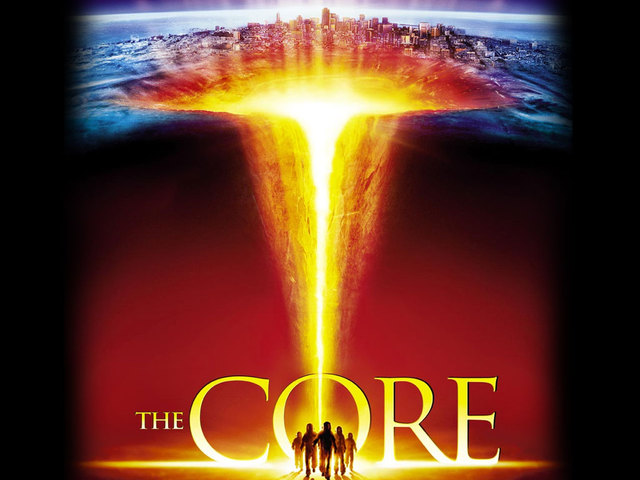In the mid-1990s scientists found evidence that Earth’s inner core, a superheated ball of iron slightly smaller than the moon, was spinning at its own pace, just a bit faster than the rest of the planet. Now a study published in Nature Geoscience suggests that around 2009, the core slowed its rotation to whirl in sync with the surface for a time — and is now lagging behind it.
The provocative findings come after years of research and deep scientific disagreements about the core and how it influences some of the most fundamental aspects of our planet, including the length of a day and fluctuations in Earth’s magnetic field.
Three thousand miles below the surface, a scorching hot ball of solid iron floats inside a liquid outer core. Geologists believe that the energy released by the inner core causes the liquid in the outer core to move, generating electrical currents that in turn spawn a magnetic field surrounding the planet. This magnetic shielding protects organisms on the surface from the most damaging cosmic radiation.
Don’t panic. The core’s slowing down isn’t the beginning of the end times. The same thing appears to have happened in the late 1960s and early 1970s, and the study authors at Peking University in China suggest it may represent a 70-year cycle of the core’s spin speeding up and slowing down.
But while other experts praised the rigor of the analysis, the study will sharpen, not settle, the fierce scientific debate about what the mysterious metal sphere at the center of the Earth is up to.
“It’s only contentious because we can’t figure it out,” said John Vidale, a geophysicist at the University of Southern California. “It’s probably benign, but we don’t want to have things we don’t understand deep in the Earth.”
The new study was led by Xiaodong Song, a geoscientist at Peking University whose work in 1996 first brought forward the evidence that the core was doing its own thing. Buried beneath the mantle and the crust, the core is too deep to visualize directly, but scientists can use seismic waves triggered by earthquakes to infer what’s happening in the planet’s innards. Seismic waves travel at different speeds depending on the density and temperature of the rock, so they act as a kind of X-ray for Earth.
The study examined seismic waves that traveled from the sites of earthquakes to sensors on the flip side of the planet, passing through the core on the way. By comparing waves from similar earthquakes that struck the same spot over the years, the scientists were able to search for and analyze time lags and perturbations in the waves that gave them indirect information about the core — or as some scientists call it, the planet within our planet.
“The inner core is the deepest layer of Earth, and its relative rotation is one of the most intriguing and challenging problems in deep-earth science,” Song said in an email.
Scientists are slowly unlocking the secrets of the Earth’s mysterious hum
The behavior of the core may be linked to minute changes in the length of a day, though the precise details are a matter of debate. The length of a day has been growing by milliseconds over centuries because of other forces, including the moon’s pull on Earth. But ultraprecise atomic clocks have measured mysterious fluctuations.
These variations may line up with changes in the core’s rotation, Song and colleagues argue. The new paper finds that, when they remove predictable fluctuations in the length of a day due to the moon’s tidal forces, there are changes that appear to track with the 70-year oscillations in the inner core’s rotation.
Paul Richards, a seismologist at the Lamont-Doherty Earth Observatory at Columbia University, worked with Song to put forward the initial evidence that the core was spinning faster than the rest of the planet.
“Most of us assumed that the inner core rotated at a steady rate that was slightly different from the Earth,” Richards said. “The evidence accumulates, and this paper shows that the evidence for [faster] rotation is strong before about 2009, and basically dies off in subsequent years.”
Still, he cautioned that things get speculative quickly when trying to understand the influence of the core on other phenomena. That’s because the behavior of the core itself is still a contested question — with simplistic assumptions increasingly refined over the years.
For example, there are lines of evidence to support other ideas about how Earth’s core is behaving. USC’s Vidale has studied seismic waves generated by nuclear explosions, and he favors a shorter, six-year oscillation for the core’s rate of rotation.
Lianxing Wen, a seismologist at Stony Brook University, rejects altogether the idea that the core is rotating independently. He argues that changes over time to the surface of the inner core are a more plausible explanation for the seismic data.
“This study misinterprets the seismic signals that are caused by episodic changes of the Earth’s inner core surface,” Wen said in an email. He added that the idea the inner core is rotating independently of the surface “provides an inconsistent explanation to the seismic data even if we assume it is true.”
What geoscientists do agree on is that as more data have accrued, many of the initial ideas about the core’s behavior have grown more complicated.
“Ultimately I don’t think that things being complicated is a problem in geoscience,” Elizabeth Day, a geophysicist at Imperial College London, said in an email. “We know the surface of our planet is complex … so it is reasonable to assume the deep interior is also complicated! To definitely say how the inner core is rotating relative to the outer layers of the planet, we will need to keep collecting as much data as we can.”
The stakes of this scientific debate are high in part because the core is a mystery that lurks, unsolved, so tantalizingly close to home.
“This is not something that’s going to affect the price of potatoes tomorrow,” Richards said. But the debate speaks to more-profound questions about Earth’s formation and how its inner layers support life on its surface, something that may aid studies of habitability on rocky planets circling other stars.
“When you think … what our planet consists of and what its history is,” Richards said, “a deep understanding of the inner core gets you into ‘How did all these divisions of planet Earth evolve?’”
The provocative findings come after years of research and deep scientific disagreements about the core and how it influences some of the most fundamental aspects of our planet, including the length of a day and fluctuations in Earth’s magnetic field.
Three thousand miles below the surface, a scorching hot ball of solid iron floats inside a liquid outer core. Geologists believe that the energy released by the inner core causes the liquid in the outer core to move, generating electrical currents that in turn spawn a magnetic field surrounding the planet. This magnetic shielding protects organisms on the surface from the most damaging cosmic radiation.
Don’t panic. The core’s slowing down isn’t the beginning of the end times. The same thing appears to have happened in the late 1960s and early 1970s, and the study authors at Peking University in China suggest it may represent a 70-year cycle of the core’s spin speeding up and slowing down.
But while other experts praised the rigor of the analysis, the study will sharpen, not settle, the fierce scientific debate about what the mysterious metal sphere at the center of the Earth is up to.
“It’s only contentious because we can’t figure it out,” said John Vidale, a geophysicist at the University of Southern California. “It’s probably benign, but we don’t want to have things we don’t understand deep in the Earth.”
The new study was led by Xiaodong Song, a geoscientist at Peking University whose work in 1996 first brought forward the evidence that the core was doing its own thing. Buried beneath the mantle and the crust, the core is too deep to visualize directly, but scientists can use seismic waves triggered by earthquakes to infer what’s happening in the planet’s innards. Seismic waves travel at different speeds depending on the density and temperature of the rock, so they act as a kind of X-ray for Earth.
The study examined seismic waves that traveled from the sites of earthquakes to sensors on the flip side of the planet, passing through the core on the way. By comparing waves from similar earthquakes that struck the same spot over the years, the scientists were able to search for and analyze time lags and perturbations in the waves that gave them indirect information about the core — or as some scientists call it, the planet within our planet.
“The inner core is the deepest layer of Earth, and its relative rotation is one of the most intriguing and challenging problems in deep-earth science,” Song said in an email.
Scientists are slowly unlocking the secrets of the Earth’s mysterious hum
The behavior of the core may be linked to minute changes in the length of a day, though the precise details are a matter of debate. The length of a day has been growing by milliseconds over centuries because of other forces, including the moon’s pull on Earth. But ultraprecise atomic clocks have measured mysterious fluctuations.
These variations may line up with changes in the core’s rotation, Song and colleagues argue. The new paper finds that, when they remove predictable fluctuations in the length of a day due to the moon’s tidal forces, there are changes that appear to track with the 70-year oscillations in the inner core’s rotation.
Paul Richards, a seismologist at the Lamont-Doherty Earth Observatory at Columbia University, worked with Song to put forward the initial evidence that the core was spinning faster than the rest of the planet.
“Most of us assumed that the inner core rotated at a steady rate that was slightly different from the Earth,” Richards said. “The evidence accumulates, and this paper shows that the evidence for [faster] rotation is strong before about 2009, and basically dies off in subsequent years.”
Still, he cautioned that things get speculative quickly when trying to understand the influence of the core on other phenomena. That’s because the behavior of the core itself is still a contested question — with simplistic assumptions increasingly refined over the years.
For example, there are lines of evidence to support other ideas about how Earth’s core is behaving. USC’s Vidale has studied seismic waves generated by nuclear explosions, and he favors a shorter, six-year oscillation for the core’s rate of rotation.
Lianxing Wen, a seismologist at Stony Brook University, rejects altogether the idea that the core is rotating independently. He argues that changes over time to the surface of the inner core are a more plausible explanation for the seismic data.
“This study misinterprets the seismic signals that are caused by episodic changes of the Earth’s inner core surface,” Wen said in an email. He added that the idea the inner core is rotating independently of the surface “provides an inconsistent explanation to the seismic data even if we assume it is true.”
What geoscientists do agree on is that as more data have accrued, many of the initial ideas about the core’s behavior have grown more complicated.
“Ultimately I don’t think that things being complicated is a problem in geoscience,” Elizabeth Day, a geophysicist at Imperial College London, said in an email. “We know the surface of our planet is complex … so it is reasonable to assume the deep interior is also complicated! To definitely say how the inner core is rotating relative to the outer layers of the planet, we will need to keep collecting as much data as we can.”
The stakes of this scientific debate are high in part because the core is a mystery that lurks, unsolved, so tantalizingly close to home.
“This is not something that’s going to affect the price of potatoes tomorrow,” Richards said. But the debate speaks to more-profound questions about Earth’s formation and how its inner layers support life on its surface, something that may aid studies of habitability on rocky planets circling other stars.
“When you think … what our planet consists of and what its history is,” Richards said, “a deep understanding of the inner core gets you into ‘How did all these divisions of planet Earth evolve?’”


